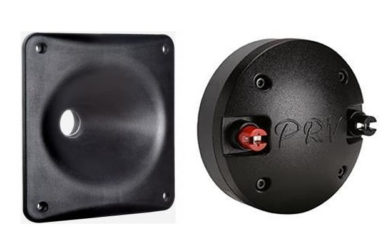| The Dayton Audio H07E is one of my favorite horns. To be more precise, it’s a specialized type of horn known as a Waveguide. The difference between a horn and a waveguide is the horn is optimized for spl whereas the waveguide trades some of the loudness for a more controlled dispersion.
Why I like the H07E, however, is not whether it’s a waveguide or a horn. First and foremost, it’s small. Only 6″x6″. These dimensions make it possible to match with drivers as small as 5.25″. It has a dispersion angle of 80° H x 50° V, which I prefer over the wide spray of dome tweeters. With a minimum recommended crossover of 2.2kHz, I can match it with woofers up to 7″ without much problems. |
 |
| Trying to find a compression driver to match a horn/waverguide is always a chore. What I’m looking for is a flat response with as little peaks and valleys as possible.
Fig 1 shows the frequency response of three screw mounted drivers I have. All were taken without any crossover. The Red trace, a Pyle PDS382, is promising. It exhibits a linear downward slope which can easily be corrected. As for the other two, I rather no deal with them. |
 (Fig 1) |
| PRV D280Ti with Dayton H07E
The PRV D280Ti is an excellent match for the H07E. Response is generally flat up to 8kHz. No CDEQ necessary. The roll-off after that can easily be corrected by eq. Black trace = RAW Horn cut-off is about 1.7kHz. |
 (Fig 2) |
| Dayton RS180S with PRV D280Ti / H07E
By chance, the Dayton RS180S is almost a perfect match. The acoustic centers of the RS180S and the D280Ti are very close, so much so that there are no cancellations on either side of the crossover (Fig 3). Electronic crossover was set at 2kHz (24dB/oct). No DELAY was added. This is ideal for passive crossovers. 2nd or 4th order for High Pass and Low Pass would be just fine. |
 (Fig 3) |
| UPDATE (Nov 15, 2016) – Peavey RX14 with H07E
Fig 4 is the H07E with a Peavey RX14 compression driver. No CDEQ is applied. It is exceptionally flat up to 6kHz, followed by a notch at 7.5kHz. Black trace = RAW |
 (Fig 4) |
| Dayton RS180S with RX14 / H07E
Fig 5 is with the electronic crossover set at 2kHz (24dB/oct). Acoustically, the RS180S and the RX14/H07E crossed at about 1.8kHz. The Red trace is the summed response. No cancellations are observed, indicating that the acoustic centers of the RS180S and the RX14 are very close. |
 (Fig 5) |
